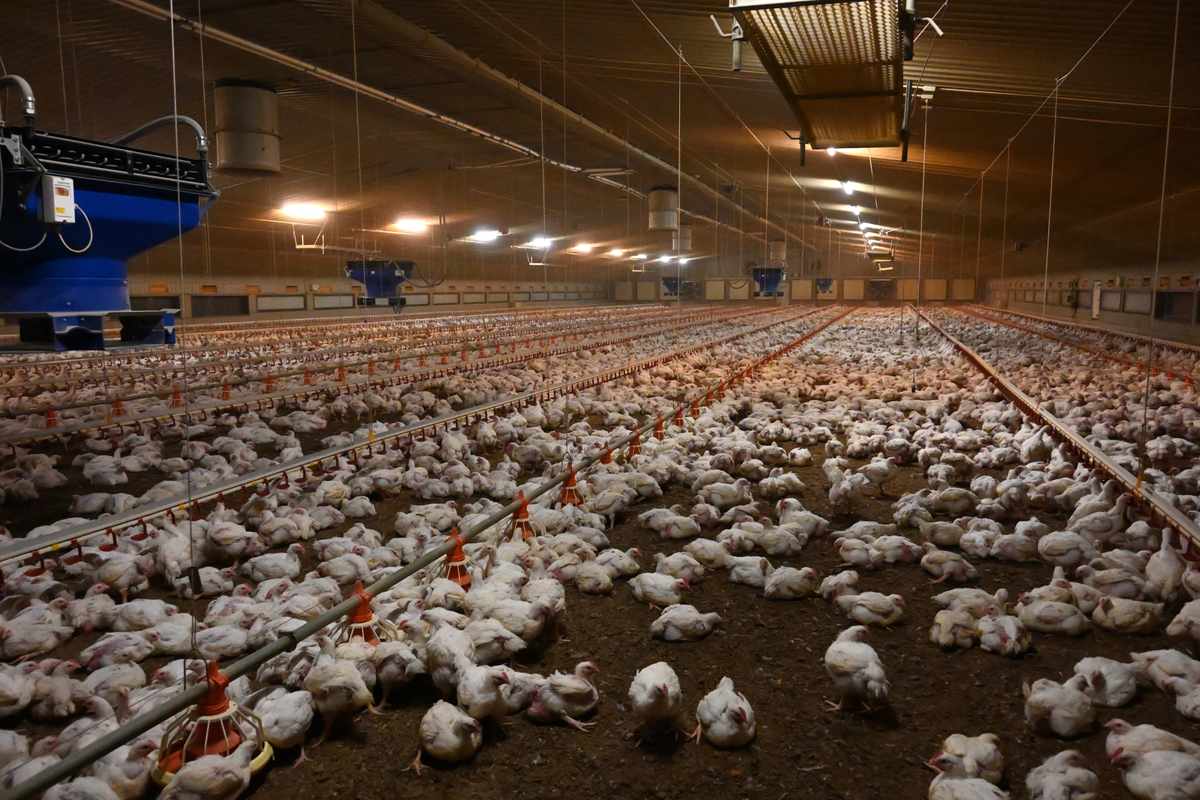Intensive Poultry Units – Out of control in Wales and other places
Intensive Poultry Units – Out of control in Wales and other places

Overbrook chicken "farm" photo credit - VIVA!
The overwhelming majority of chickens in the United Kingdom are reared in intensive poultry units (IPUs). The defining characteristics of such units are the very large numbers of birds and the high density at which they are kept. IPUs typically house several tens of thousands of chickens but may house 200,000 or even more. Some hold chickens reared for meat, known as ‘broilers’. Predominantly, these are housed indoors, though broilers may also be produced in intensive free-range systems. IPUs also include units which house egg-laying hens. These include units in which the chickens are kept in cages, but also large-scale free-range units. Other large units house breeding chickens. In recent years, there has been an explosion of IPUs in central Wales, particularly in the county of Powys, and in the Borders. But there is now growing opposition to them….
Ecological harms
Particular concerns have been highlighted about the impact of IPUs on the ecological status of rivers. In Wales, these include the Wye and the Usk. Often IPUs have been sited in river catchments. The chickens in IPUs produce a very large amount of urine and faeces. These result in the production of ammonia which can enter the atmosphere or be deposited on land. The manure produced may be spread on land, either locally or elsewhere, contributing not only to the further production of ammonia, but also of nitrous oxide, a potent greenhouse gas. Nitrates and phosphates (chicken manure has a particularly high phosphate content) can leach into rivers, causing eutrophication and damaging biodiversity. While there are other sources of pollution too - producers in the past have sought to deflect blame onto these - the evidence is now unequivocal that pollution from IPUs is damaging river ecology in Wales. The ecological impacts go much further though, with, for example, significant risks to woodland and other terrestrial habitats. The major IPU culprits in Wales are indoor broiler chicken units and large-scale free-range egg units which have spread the most rapidly.
Animal welfare harms
All types of IPUs are associated with animal welfare harms. Perhaps the most egregious are intensive indoor broiler chicken units. The current ‘welfare’ regulations allow for stocking densities of about 19 full-grown chickens per square metre. The sheds are barren – the chickens have no opportunity to express natural behaviour. The chickens have been genetically selected to grow very rapidly with a view to slaughter at about 6 weeks. The chickens’ legs cannot support the weight of their bodies as they grow and lameness is a serious problem – more than 90% of broiler chickens experience some degree of lameness for about a third of their lives. Other welfare problems include burns due to standing or lying in urine-saturated litter and respiratory distress associated with inhalation of ammonia. Birds, either because they cannot walk or are crushed and unable to reach the feeders, can die slowly of starvation and dehydration. Depopulation of the sheds prior to slaughter is often rough and brutal.
Egg-laying hens, in almost all systems, will be ‘debeaked’ shortly after hatching to prevent feather pecking which results from the intensive conditions of rearing. This is a painful operation with often long-lasting effects. Male chicks produced by breeding hens will be destroyed shortly after hatching as they are of no use to the egg producers. In cage-based systems movement and behaviour will be severely restricted. Free-range IPUs, while preferable in some respects, will nonetheless involve significant restrictions to behaviour – the high densities and large numbers impact negatively on the birds’ behaviour. One of the world’s leading authorities on animal welfare, Professor (now Emeritus) John Webster has stated, ‘the welfare of laying hens in large, commercial colony systems is at least as bad as that of hens in the conventional battery cage’.
Threats to public health
Rearing such large numbers of birds at high density creates significant risks of infection. Bacteria that can proliferate include Campylobacter, Salmonella, Staphylococcus, E.coli strains and many others. While there have been quite marked reductions in amounts used in the U.K. poultry industry since about 2012, and it is claimed by the industry that antibiotics are no longer administered for growth promotion or preventatively, antibiotics continue to be administered to flocks, most often to groups of birds following infection outbreaks to prevent further infection. This represents a potential cause of antimicrobial resistance.
The chickens kept under these conditions also present an ideal environment for the proliferation of viruses, including bird flus. The H5N1 strain which is currently circulating worldwide has infected UK flocks. It has now been found to be transmissible both to and between mammals.The potential for generation of bird flu strain varieties that can be transmitted between humans is very real. Moreover, emissions, such as those of ammonia, have the potential to interact with particulates in the atmosphere generating risks to human respiratory health.
Overbrook chicken "farm" photo credit - VIVA!
Growing opposition
There has been growing opposition to IPUs in Wales. This has come from established organisations with a strong concern for the environment, including the Campaign for Rural Wales, the Wildlife Trusts, and Plantlife, but also from organisations such as the Landworkers Alliance, representing the many individuals, often working in smaller scale enterprises, who work on the land and wish to develop sustainable approaches to food production and land use. Increasingly, the pressure has come from small community groups often set up in response to planning applications for yet more IPUs in their local area. Planning applications for IPUs in Wales will now often receive many hundreds of objections.
There have been persistent calls for a moratorium on the approval of IPUs and demands that there is much more effective monitoring of water and atmospheric quality. In addition, some groups have emphasised the impact of IPUs on deforestation, through the import of large amounts of soya feed, which, in turn has impacted negatively on indigenous communities. Campaign groups have become increasingly sophisticated, sometimes seeking expert legal advice and representation. There have been one or two successes, including, for example, that of the local group Sustainable Food Knighton which successfully initiated a judicial review of a council’s decision-making, resulting in the overturning of an application, though a further application was later approved. There have been several applications refused in recent years (more than previously), though the overwhelming majority continue to be ‘rubber-stamped’.
Nothing to do with us
What has driven the proliferation of IPUs has been consumption. Retailers have sought to capitalise on demand. Often their supplier will be an agribusiness (often located outside of the U.K.) which will contract local poultry farmers to produce for them. In the case of broiler chickens, a typical business model is for a farmer to obtain a loan to set up the shed(s) while the multinational buses in the chicks, bedding, foodstuffs and labour for most of the processes, including removing the ‘finished birds’ for slaughter at the processing plant. The farmer does not even own the chickens but effectively provides a fattening and effluent disposal plant to supply the multinational with the end-product.
However, no-one seems to be prepared to take responsibility. Large retailers which are directly sourcing their chickens from IPUs in the catchments of the Wye, for example, protest their environmental responsibility and have changed their sourcing not a jot. They, like the agribusiness companies involved which also seek to convey their environmental credentials (against evidence), have also sought to deflect the blame, emphasising other causes of pollution. Individual farmers are also directly responsible. None ever acknowledge the massive animal welfare harms.
Avoiding blame is an activity that extends to public bodies too. An astonishing proliferation of IPUs in the county of Powys, with 115 units approved between 2015 and 2018 alone, has been defended by the Council in terms of their meeting regulations, but it seems clear that poultry business operators view Powys as an open opportunity. Natural Resources Wales, the relevant environment agency, has failed to effectively intervene to address cumulative effects. Moreover, they have been heavily criticised for failing to monitor waterways, with this increasingly being undertaken by voluntary groups. The Welsh Government, until quite recently, has been effectively silent on the issue, acting as if the proliferation of the units nationally has nothing to with them.
A challenge
It has proved very difficult to stop what can appear like a tide of damaging IPU developments. As it stands, most IPUs (including intensive broiler units) do not breach animal welfare regulations as these are exceptionally limited. Concerns have been expressed about a failure of local authorities to properly apply environmental conditions to applications. There has been concern too that planning applications for IPUs most often are not even considered by a planning committee, but are, instead, decided under ‘delegated powers’ by a council officer. However, the nature of the regulations themselves – their lack of clear criteria for rejection on environmental grounds – has led councils, whether a planning committee is involved or not, to avoid rejecting applications for fear of costly appeals. There has been an apparent failure by local authorities to consider possible cumulative effects, though the lack of available information may have been a factor, and a lack of action by NRW and the Government on this. There have been persistent failures to effectively monitor IPU pollution and impacts.
Conclusions
There is a limit to what the land (and its waterways) can sustain. It cannot cope with relentless pollution. It cannot cope with excessive numbers of animals reared in vulnerable landscapes. It seems clear that there is a common cause to each of the negative consequences highlighted, and that is an almost total disregard for the welfare of the animals used. As a result, they are crammed, and pressured and stressed in enormous numbers with no regard to their needs or natures. Pollution and health risks follow.
There is a need for reduced consumption of meat and dairy products – this is something that everyone can play a part in. But there is a need for serious action by public bodies too. At minimum welfare regulations need to be drastically enhanced – Wales, with devolved powers, could do this. Planning regulations and guidance need to be rewritten to enable councils to reject IPU applications straightforwardly where their overall effect is harmful. They also need to enable consideration of cumulative effects at local level. We should not be importing soya feed in large quantities to feed chickens reared here with adverse effects on the environment and communities elsewhere.
In Wales, an Agriculture Bill is in process which is meant to rest on a principle of ‘sustainable land management’ (SLM). The proliferation of IPUs in Powys and elsewhere is in no way sustainable, yet the draft Bill makes no mention of them. Wales has previously been praised for its introduction of another Act designed to ensure that our actions now do not harm others in the future. It is termed ‘The Well-being of Future Generations Act’. The proliferation of IPUs in Wales directly contradicts its key principle…..sustainability.



